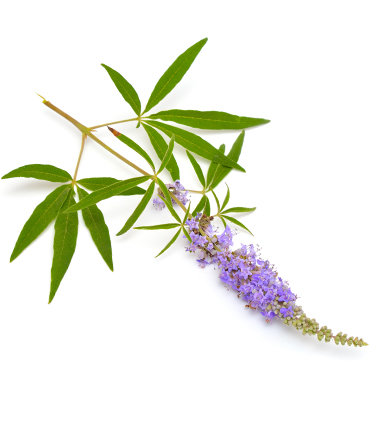
Chasteberry

Latin name:
Vitex agnus-castus L.
Common names:
Monk's pepper, Chaste lamb,
Pepper tree, Lamb's vine
Family:
Verbenaceae
Parts of the plant used:
Fruits (berries)
Description
Don't be fooled by its bluish and purple, fragrant and honey-scented flowers. Its Latin name Vitex agnus-castus comes from the Greek word agonos, meaning « infertile ». The chestnut tree is also called « monk's pepper » or « chaste lamb ». It is easy to understand why this plant was once known as an anaphrodisiac. In spite of this, the chestnut has many virtues.
Its fruits contain flavonoids (flavones, including oriental, vitexin and casticin) as well as iridoids (eurostoside, agnuside and aucuboside) and diterpenes (rotundifuran and vitexilactone).
The chaste tree is used for its endocrinological and gynaecological action. Thanks to its emmenagogue properties, this plant stimulates the menstrual blood flow in the pelvic and uterine region. Its effect is recognised in cases of irregular menstrual cycles, luteal insufficiency and hyperproduction of prolactin. Chaste tree is anti-estrogenic and anti-androgenic, which allows a rise in progesterone concentrations during the middle of the cycle.
« Chaste lamb » regulates premenstrual disorders, including irritability, breast pain (mastodynia), migraines and breast tension.
Chaste lamb is also traditionally used for minor sleep disorders in adults and children.
The pharmacological properties of this plant on hormonal regulation make it possible to slow down the libido of men whose sexual needs can be great or even compulsive, and whose impulses are likely to cause problems.
The benefits
The chaste tree is used in particular in the case of irregular female cycles. The plant reduces premenstrual discomforts such as migraines, irritability, breast pain and tension.
Chaste tree berries used in phytotherapy help to maintain a good physiological comfort during the menstrual cycle and contribute to the reduction of menstrual pain.
Our products based on Chasteberry
-
€25.10
-
€20.90













Recommandé par mon médecin, je l'utilise régulièrement, avec de tvoir plus
Avis du 28/09/2024, suite à une expérience du 11/09/2024 par Silvia S